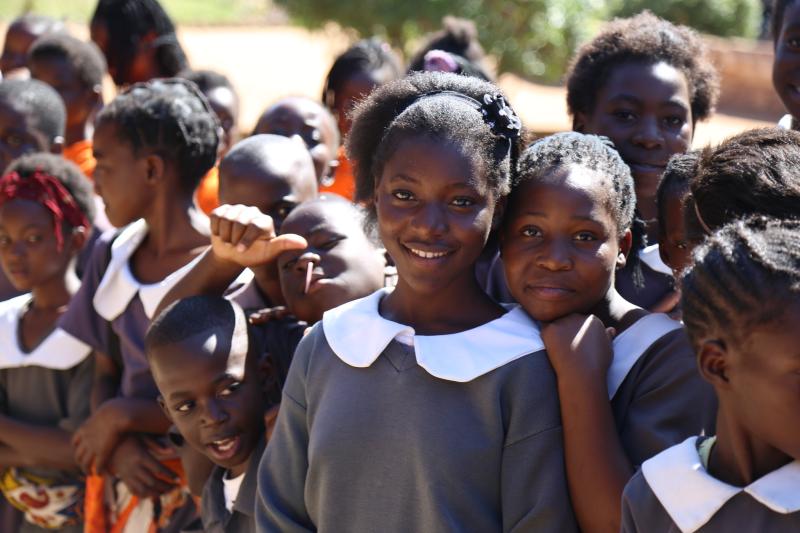
There are hopeful signs that the education access gap between boys and girls in African countries is closing. An overview of gender equity and inclusive education policies and practices in 18 African countries shows that continued policy efforts are strengthening gender equality and disability and special needs education.
A review of historical data on participation in education shows a steady increase in gender parity -- growing from 21% in 2005 to 48% in 2021. More recently, reports from knowledge sharing and capacity building events across the Global Partnership for Education Knowledge and Innovation Exchange (GPE KIX) network show that addressing gender equality in education is a priority for ministries of education in GPE member countries.
However, trends across regional, national, and subnational levels also show that girls are less likely to complete primary and secondary school. GPE KIX marks this year’s International Day of the African Child by reflecting on the progress to enhance enrolment in education and learning outcomes for pregnant girls in African countries.
Teenage pregnancies and schooling
Poor implementation of school re-entry policies has forced many pregnant girls to drop out of school. This was exacerbated during the pandemic with many countries in Africa recording high numbers of teenage pregnancies during school closures. The KIX COVID-19 Observatory report on school reopening in Africa during COVID-19 highlights some challenges facing girls. For example, education systems do not collect gender-disaggregated data, or track student progress and policies for smooth re-entry in a manner needed to understand and address the needs of girls.
Practical examples of well-tested interventions that enhance girls’ education include reducing or eliminating fees for girls, offering scholarships and books and other basic needs, such as sanitary towels and meals, and providing mentorship, guiding and coaching. These interventions, however, must be anchored on effective school re-entry policies that allow pregnant girls to go back to school.
The good news is that many countries in Africa have instituted school re-entry policies, for example:
Zambia’s Re-entry Policy, which requires all schools to grant girls maternity leave and readmit them to facilitate girls’ education.
The widely applauded decision of Tanzania to allow teenage mothers to go back to school after giving birth.
Kenya’s National Guidelines for School Re-entry, which facilitates re-entry into learning institutions for learners who dropped out of school for various reasons, including learners with special needs and disabilities.
Malawi’s readmission policy, which seeks to eliminate biases in the education system by ensuring pregnant girls can go back to learning.
School re-entry policies go together with community awareness-raising
While appreciating the role of policy in providing the legal basis for the enrolment of teenage mothers in school, their effectiveness must be accompanied by adequate awareness creation among girls and families about the policy, awareness for school leaders and teachers so they may provide the necessary conditions for girls to go back to school, and collective effort to address the potential cultural challenges that may inhibit learning for the girls as highlighted in the assessment of the effectiveness of Zambia’s school re-entry policy.
What changed during and after the pandemic
A KIX COVID-19 Observatory report on the wellbeing of school children in Africa during the COVID 19 pandemic notes that even prior to the onset of the pandemic, several countries lifted bans and initiated re-entry programs for adolescent girls to return to school. During the pandemic and school reopening, education systems adopted measures to protect girls against sexual violence and teenage pregnancy and promote school re-entry through targeted campaigns and awareness about gender-based violence and adolescent reproductive health.
At a KIX Africa 19 webinar on Reaching and Teaching the Girl Child in the COVID-19 Era, Zimbabwe shared their back-to school campaign that provided opportunities for community dialogue sessions on the importance of school re-entry for children with disabilities, pregnant teens and those in underaged marriages across districts in the country. An example from West Africa is Sierra Leone’s decision to recruit more female teachers while intensifying public education – using radios, televisions, social media, and town hall meetings – on the value of inclusive policy designed to leave no one behind.
Other improvements beyond educating teenage mothers are also being discussed. At a KIX Africa 19 learning event on preventing school related gender-based violence, Uganda, which recently reopened schools after a two-year closure, reported that the ministry of education will continue working with other stakeholders to integrate sexual reproductive gender-based violence education into the curriculum. Specifically, the ministry of education has developed guidelines to implement gender responsive pedagogies and trained expert teachers at the school community level to mentor other teachers and learners to be gender sensitive and to avoid biases and discrimination.
The progress made by African countries towards promoting school re-entry for girls is remarkable but not enough. IDRC, GPE and the GPE KIX mark the International Day of the African Child by continuing to invest in evidence and research about what works in education, the sharing and use of that knowledge across borders, and addressing structural barriers that work against access and retention in education.
